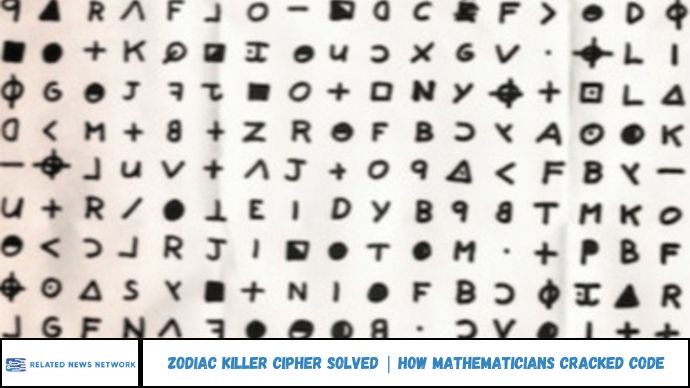How mathematicians cracked the Zodiac Killer’s cipher is a thrilling story of persistence, pattern recognition, and advanced cryptography. This article explores the mystery of the infamous 340-character cipher, the techniques used to finally decode it in 2020, and how modern mathematics and computing power played a crucial role. From historical background to codebreaking methods, discover how decades-old secrets were finally revealed.
Few criminal cases have gripped the world—and eluded investigators—quite like that of the Zodiac Killer. Operating in the late 1960s and early 1970s, this still-unidentified serial killer terrorized Northern California, not just through violent attacks but through his taunting letters filled with cryptic codes sent to local newspapers.
Among these chilling correspondences, one stood out above the rest: a 340-character cipher mailed in November 1969 to the San Francisco Chronicle. For over 50 years, this mysterious puzzle mocked law enforcement and amateur sleuths alike, resisting every effort to decode its secrets.
A Killer Who Communicated in Ciphers
The Zodiac’s letters weren’t just confessions—they were psychological games, full of riddles, symbols, and threats. He claimed responsibility for murders, teased authorities with clues, and demanded his ciphers be printed publicly to prevent further violence. While earlier codes like the Z408 were quickly cracked, the so-called Z340 cipher remained unsolved for decades, becoming one of the most famous unsolved codes in criminal history.
How Mathematicians Cracked the Zodiac Killer’s Cipher
“This is the Zodiac speaking…” — chilling words from one of America’s most infamous serial killers, accompanied by encrypted messages that puzzled experts for over 50 years.
What happens when one of the world’s most mysterious unsolved codes meets 21st-century mathematics and computing?
In this article, we’ll explore:
- The background of the Zodiac ciphers
- How the 340-character cipher resisted decades of decryption attempts
- The breakthrough moment in 2020
- The tools and mathematical techniques used
- Why this matters in the world of cryptography
Let’s decode the story behind the code.
The Zodiac Killer’s Ciphers: A Cold Case Code
Between 1968 and 1969, the Zodiac Killer terrorized Northern California. Along with his crimes, he sent cryptic letters and ciphers to newspapers, taunting the police and the public.
The Ciphers He Sent:
- Z408 (1969): Solved quickly by a high school teacher and his wife.
- Z340 (1969): A more complex cipher that remained unsolved for over 51 years.
- Z13 and Z32: Smaller, still unsolved ciphers.
While Z408 revealed disturbing insights into his motives, Z340 was his true enigma.
The Breakthrough: How Z340 Was Finally Solved
In December 2020, a team of amateur codebreakers — David Oranchak (USA), Jarl Van Eycke (Belgium), and Sam Blake (Australia) — finally cracked the 340-character cipher. Their approach combined linguistic analysis, mathematical modeling, and software tools.
Key Techniques They Used:
- ZKDecrypto: A custom code-breaking tool that tested thousands of permutations.
- Transposition cipher logic: The team realized the text was rearranged in a diagonal pattern.
- Pattern recognition: By searching for likely words and phrases, they could reverse-engineer the cipher’s logic.
The decrypted message began chillingly:
“I hope you are having lots of fun in trying to catch me…”
It didn’t reveal his identity — but confirmed his taunting nature.
Mathematics Behind the Cipher: Patterns, Permutations & Probability
The cipher’s complexity lay in how letters were rearranged. This wasn’t simple substitution — it involved a homophonic substitution cipher combined with transposition.
Mathematical Concepts Applied:
- Combinatorics: Analyzing possible arrangements of characters.
- Frequency analysis: Studying how often certain symbols appeared.
- Heuristics and algorithms: To narrow down likely configurations.
- AI-powered brute-force simulations: Running thousands of solutions rapidly.
This blend of human intuition and machine logic proved essential in solving a decades-old mystery.
What This Means for Cryptography and Cold Cases
The solution to Z340 is more than a historical footnote — it’s a testament to the power of crowdsourced problem-solving and modern cryptographic tools.
Why This Breakthrough Matters:
- Inspires new approaches to solving cold cases
- Validates the importance of interdisciplinary teamwork
- Reinforces how math can be used to crack real-world mysteries
As computing power grows, so too does our ability to uncover long-buried secrets.
FAQs
1. Who solved the Zodiac Killer cipher?
A team led by David Oranchak, Jarl Van Eycke, and Sam Blake cracked it in 2020.
2. What is the Zodiac 340 cipher?
It’s a 340-character cryptogram sent in 1969 by the Zodiac Killer, unsolved until 2020.
3. What tools were used to solve the cipher?
They used codebreaking software like ZKDecrypto and applied cryptographic math.
4. Did solving the cipher reveal the Zodiac’s identity?
No, it confirmed his messages but did not expose his name or identity.
5. Why did it take so long to solve?
Its complex transposition and lack of context made traditional methods ineffective.
6. Are other Zodiac ciphers still unsolved?
Yes, the Z13 and Z32 remain mysteries as of 2025.
Conclusion
The cracking of the Zodiac Killer’s 340-character cipher stands as one of the most compelling examples of how math, persistence, and technology can come together to unravel even the most cryptic messages. Though his identity remains hidden, each solved puzzle brings us a step closer to the truth — and reminds us that no code is truly unbreakable.







